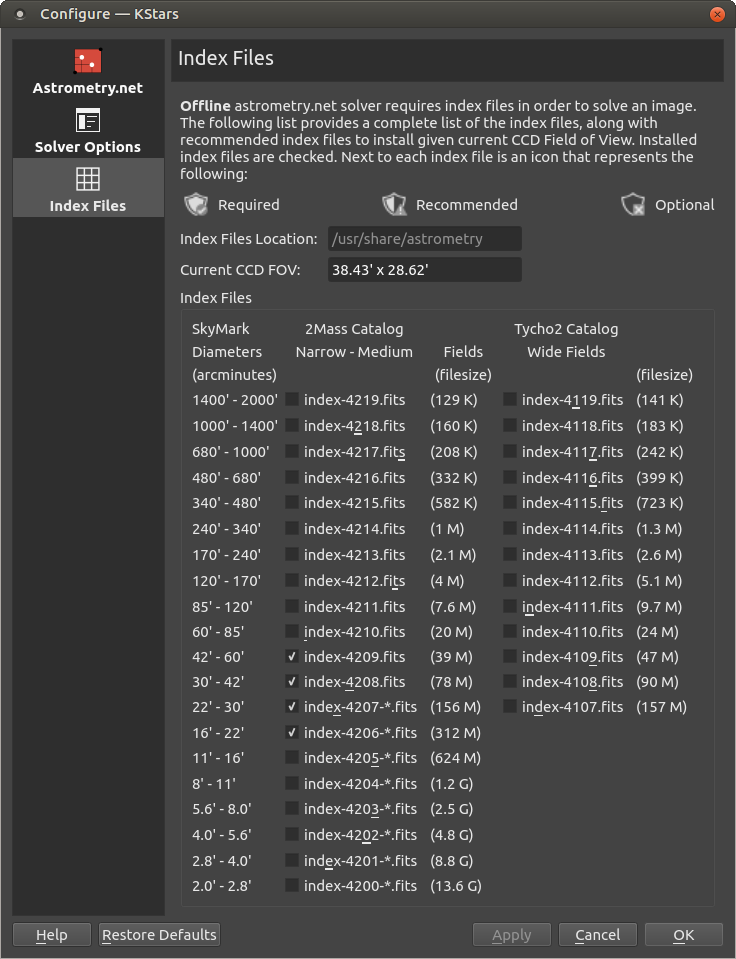

- #Installing astrometry index on ekos kstars drivers#
- #Installing astrometry index on ekos kstars upgrade#
- #Installing astrometry index on ekos kstars full#
- #Installing astrometry index on ekos kstars software#
- #Installing astrometry index on ekos kstars Pc#
The Pi 4 is indeed a nice upgrade for running KStars/Ekos. I'm curious to see if the RPI4 is an improvement or just draws more power.Įxperienced users, any lessons learned or features to explore? (btw I measured the power for the RPI - 460mA average current for those of you wondering.)
#Installing astrometry index on ekos kstars Pc#
I have also used a Linux PC running Kstars/ Ekos successfully.įor focusing try connecting to the RPI via VNC from your phone or a tablet - it makes real-time focusing much easier.Ī RPI4 (8Gb) is on order with a 12V USB hub will let me run everything off 12V soon. The RPI 3B+ works great for me so far - doing everything local to the RPI (imaging, image storing, guiding, alignment, plate solving) Once I got a dummy battery connected to a good USB 003A source that problem went away.
#Installing astrometry index on ekos kstars full#
My next thing to try is the auto dark correction for previews to help get the exposures right.Īs far as the camera dropping out - if it comes back - check the power to the camera - I found my Canon 600D can be quite flaky when not running at full charge. (auto flat duration! wow - taking those perfect flat images now.) I have been using the Astroberry/ Ekos combo for only a couple months and am still learning. and I *did* get a little bit of data to process, but not as much as I would have liked before the clouds rolled in. last night was really about just getting everything running. The Rpi performed very well, but I think once I introduce a guider into the mix, I'll probably want to upgrade to an Rpi 4. I suppose aperture control is an issued faced only by DSLR imagers (or folk using DSLR lenses anyway).Īll things considered, I'd have to qualify last night's experiment as a success. I guess I'm relying on the physical camera settings for aperture. There's a lot of that in BYE, that helps with focus and framing etc. One thing that I found myself looking for and didn't find was DLSR aperture control. Setting up the imaging run wasn't terribly difficult, and I actually see a LOT of potential there for pre-planning and scheduling and those sorts of things that permit amateur astronomers to kick off an imaging run and just let it go. In spite of that gross error, Ekos was able to plat solve and get my target centered. like maybe 60 minutes? I haven't gotten to the bottom of that yet, but I'll be looking very closely at things like time zone settings. What I found a little unsettling was that my go to was off by quite a bit in RA. I was using an on-line method, since the Rpi was hooked up to my network, and hence could access directly. The plate solver built into Ekos worked very well. That's a setting that has to be changed on the camera, and I set it to 8 minutes which I think should suffice. I *think* that my problem was that the auto-shutoff on the camera was set to only about 30 seconds. Kind of a pain to have to keep recycling power to the camera, and re-starting the Rpi. My biggest issue for the imaging run last night was that my camera kept loosing connections to Ekos. Of course, if/when I swap out that Canon lens for some better glass, I'll have to re-think my focusing routines and consider things like Bahtinov masks. Ekos will also drive the Canon lens focuser, but the feedback isn't as clear and immediate.

That's probably because I'm using a Canon autofocus lens, and can drive the focuser step by step from BYE, and get immediate visual and numerical feedback. Additionally, I thought the focusing operations in BYE were a lot better. Not surprisingly, BYE was a lot more intuitive for camera control. Prior to using Astroberry, I was running Backyard EOS for camera control, and Astrotortilla for plate solving. I don't have a quider, so getting that setup is not something I can comment on. Quite a few pictures of the basement to show for my efforts. my Wifes!) Canon 100D connected went pretty well too. It wasn't too long before I was slewing all over the basement.
#Installing astrometry index on ekos kstars drivers#
The 3rd party INDI drivers were easy enough to find, and install. The next hurdle was getting the Rpi to talk to my iOptron IEQ30 Pro. Suffice to say, things like SSIDs are case-sensitive! There's quite a bit of guidance on this on the web. The first challenging part was getting Astroberry connected to my home network.

I enjoy hacking away at computers (including the embedded computers that live in our mounts and cameras), but if that's not your thing, then maybe get some help with this.
#Installing astrometry index on ekos kstars software#
Additionally, there's quite a bit of software to be learned. TLDR Getting everything setup and working together can be challenging. I got my feet wet with an Astroberry imaging session last night.


 0 kommentar(er)
0 kommentar(er)
